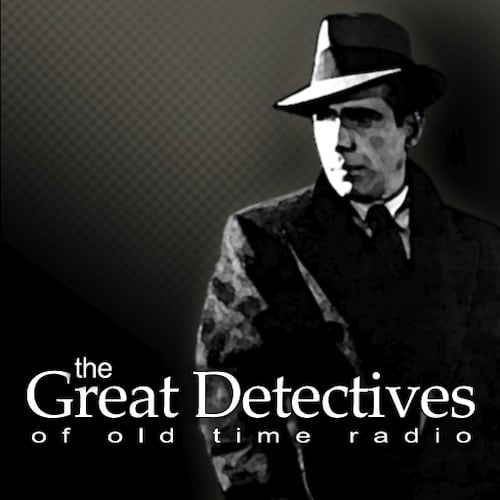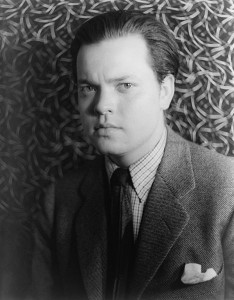When I began compiling my list of radio’s most essential people, I wanted to honor the people who’d made the greatest impact on radio. I also wanted to represent every type of person who contributed to great radio. It’d be easy to make a list full of leading actors and actresses. But that wasn’t the stuff of old time radio. It was comedy, drama, and music. I wanted to be sure that the character actor and actresses who made radio truly great got their due, as did the creative minds who made programs like Yours Truly Johnny Dollar and Boston Blackie as good as they weren’t without appearing behind the mike.
So after eight months, the list is done.
We had 100 names and they included lead actors, comedians, singers, band leaders, character actors, writers, and announcers. Of course, along the way, I’ve had questions and even as I look at the list there are a few calls I struggled with.
The biggest regret were all the people who couldn’t quite fit into the top 100, so I’ll offer some honorable mentions:
Character Actors/Actresses:
Parley Baer
Herb Vigran
Barney Philips
Betty Lou Gerson
Stacy Harris
J. Carrol Naish
Lead Actor:
Alan Ladd
Comedy Teams:
The Easy Aces
Vic and Sade
Announcers:
Carlton Kadell
Don Willson
Band Leaders:
Paul Whiteman
Benny Goodman
Of course, our own biases play into our picks. Some fans may feel I overrated some choices such as Meredith Willson (#37) and Gordon Macrae (#28). Maybe, but I feel they’ve been underrated for far too long.
The toughest choice was #1. To be honest, throughout the eight months, I went back and forth between Welles and Benny. In the end, my conviction settled around Welles, though I definitely understand the case for Mr. Benny.
My hope with this list is not that this be the last word in greats of radio, but that’ll inspire others to honor and write about the folks who made radio.
I want to acknowledge the valuable information provided by the Digital Deli, Radio Goldindex, and John Dunning’s On the Air for the invaluable help they provided in making this list.
Below is list with links to each article. Please note that all items between links are covered at the top link. So the link on the #100 list will contains ranks for #96-100, and the link on #95 will contain information on #91-95, and so on.
100) Vic Perrin-Character Actor.
99) Jock Macgregor-Writer, Producer, Director.
98) Humphrey Bogart, Actor, star of Bold Venture.
97) Dennis Day-Singer, star of A Day in the Life of Dennis Day.
96) Barton Yarborough, Character Actor.
95) Lon Clark, Actor, Star of Nick Carter.
94) Shirley Mitchell, Character Actress.
93) William Bendix, Star of The Life of Riley.
92) Edward Arnold, Actor, Star of Mr. President.
91) Frances Langford, Singer, Star of The Bickersons.
90) Frank Nelson, Character Actor.
89) Bill Goodwin, Announcer and Actor.
88) David Friedkin and Morton Fine, Writing Team-Broadway’s My Beat.
87) Raymond Burr, Character Actor and Star of Fort Laramie.
86) Frank Sinatra, Singer, Actor, Star of Rocky Fortune.
85) Himan Brown, Producer/Director-Flash Gordon, Inner Sanctum, Barrie Craig, Confidential Investigator, CBS Mystery Theater.
84) William Gargan, Actor/Announcer, Star of I Deal in Crime, Martin Kane, and Barrie Craig.
83) Damon Runyan, Writer.
82) Mandell Kramer, Character Actor, Star of It’s a Crime, Mr. Collins and Yours Truly Johnny Dollar(1961-62).
81) Lucille Ball, Comedienne, Actress, Star of My Favorite Husband.
80) Arthur Godfrey, Singer, Talk Show Host.
79) Les Damon, Actor, star of The Thin Man, the Adventures of the Abbotts, The Adventures of the Falcon, ABC Mystery Theater.
78) John Dehner, Character Actor, Star of Have Gun, Will Travel.
77) Robert Ripley, Host of Ripley’s Believe it Or Not.
76) Robert Young, Actor, Star of Father Knows Best.
75) Fanny Brice, Comedienne, “Baby Snooks.”
74) Lionel Barrymore, Actor, Star of “Mayor of the Town, “Scrooge” in annual live performances of The Christmas Carol.
73) Gene Autry-Western Singer.
72) William Johnstone, Character Actor, Star of The Shadow and The Line Up.
71) Anne and Frank Hummert-Radio Writers and Producer Team.
70) Groucho Marx, Comedian, Host of You Bet Your Life.
69) Martha Wilkerson-GI Jill, host of The GI Jive during World War II.
68) Basil Rathbone-Actor, star of The New Adventures of Sherlock Holmes, Scotland Yard, and Tales of Fatima.
67) Ozzie and Harriet-Actor/Actress, Band Leader and Singer, Stars of The Adventures of Ozzie and Harriet.
66) Fredrick Ziv-Producer of Syndicated radio programs including Boston Blackie, I Was a Communist for the FBI, and The Cisco Kid.
65) Harry Bartell, Announcer, Character Actor.
64) Cathy Lewis, Actress, Star of On Stage.
63) Abbott and Costello, Comedy Team.
62) Rudy Vallee, Singer, Variety Show Host.
61) Don Ameche, Announcer, Actor, Star of The Bickersons.
60) Harold Peary, Comedian, Singer, Star of The Great Gildersleeve and The Harold Peary Show.
59) Art Linkletter, Announcer, Host of People Are Funny and House Party.
58) Arch Oboler, Radio Writer for Light’s Out and Arch Oboler’s Plays.
57) Mercedes McCambridge, Actress, Star of Defense Attorney.
56) William N. Robson-Producer/Director/Write-Escape, Suspense, Man Behind the Gun.
55) Ben Wright, Character actor, Star of Sherlock Holmes and Pursuit.
54) Hans Conreid, Character Actor.
53) Hebert Marshall, Actor, Star of The Man Called X.
52) Phil Harris, Singer, Comedian, Star of The Phil Harris and Alice Faye Show
51) Jeanette Nolan, Character Actress.
50) Howard Duff, Actor/Announcer, Star of Sam Spade.
49) Eve Arden, Actress, Star of Our Miss Brooks.
48) Claudia Morgan, Actress, Star of The Thin Man and The Adventures of the Abbotts.
47) Eddie “Rochester” Anderson, Comedian.
46) Jean Hersholt, Actor, Star of Dr. Christian.
45) Agnes Moorhead, Character Actress.
44) Jackson Beck-Actor, Announcer on Adventures of Superman.
43) Jack Moyle, Character Actor, Star of Rocky Jordan.
42) Frank Lovejoy, Character Actor, Announcer, Star of Night Beat.
41) Gertrude Berg, Writer/Actress, Star of The Goldbergs.
40) Gerald Mohr, Character Actor, Star of The Adventures of Philip Marlowe.
39) Edgar Bergen, Comedian, Ventriloquist.
38) Alan Reed, Character Actor.
37) Meredith Willson, Actor, Song Writer, Band Leader.
36) Red Skelton , Comedian.
35) Glenn Miller, Band leader.
34) Norman Corwin, Writer.
33) Jimmy Durante, Comedian.
32) Carlton Morse, Writer and Producer of One Man’s Family and I Love a Mystery.
31) Dick Powell, Singer, Actor, Star of Rogue’s Gallery and Richard Diamond Private Investigator.
30) William Spier, Producer/Director-Suspense, Duffy’s Tavern, The Adventure’s of Sam Spade.
29) Paul Frees, Character Actor.
28) Gordon McRae, Singer, Star of The Railroad Hour.
27) Bud Collyer, Announcer, Star of The Adventures of Superman.
26) Eddie Cantor, Comedian and Singer.
25) Norm McDonnell, Producer/Director of Adventures of Philip Marlowe and Gunsmoke.
24) Kate Smith, Singer, Talk Show Host/Variety Show Host.
23) Bruce Beamer, Actor, star of The Lone Ranger.
22) Fred Allen, Comedian.
21) Mel Blanc, Character Actor.
20) Lum ‘n Abner, Comedy team (Norris Goff and Chester Lauck.)
19) Lurene Tuttle, Character Actress.
18) Jack Johnstone, Writer, Director, Producer, Adventures of Superman, The Man Called X, and Yours Truly Johnny Dollar.
17) Dinah Shore, Singer.
16) Amos’n Andy, Comedy Team (Freeman Gosden and Charles Correll.)
15) Lawrence Dobkin, Character Actor, star of The Adventures of Ellery Queen.
14) George Burns and Gracie Allen, Comedy Team.
13) Bob Bailey, Actor, Star of Let George Do It and Yours Truly Johnny Dollar(1955-60).
12) Al Jolson, Singer, Variety Show Host.
11) Jack Webb, Actor/Director, Creator and Star of Dragnet, Star of Pat Novak for Hire and Jeff Regan.
10) Joseph Kearns, Character Actor.
9) Elliot Lewis, Actor, Producer, Director, star of Voyage of the Scarlet Queen, Casebook of Gregory Hood, Producer of Broadway’s My Beat and Suspense.
8) Fibber McGee and Molly, Comedy Team (Jim and Marion Jordan).
7) William Conrad, Character, Star of Gunsmoke.
6) Gale Gordon, Character Actor, star of Flash Gordon and Casebook of Gregory Hood.
5) Virginia Gregg, Character Actress.
4) Bing Crosby, Singer.
3) Bob Hope, Comedian.
2) Jack Benny, Comedian.
1) Orson Welles, Actor, Director, Producer, Writer. Director and Star of <i>The Mercury Theater</i> programs. Star of <i>The Shadow</i> and <i>The Lives of Harry Lime</i>.
If you enjoyed this post, you can have new posts about Detective stories and the golden age of radio and television delivered automatically to your Kindle.

